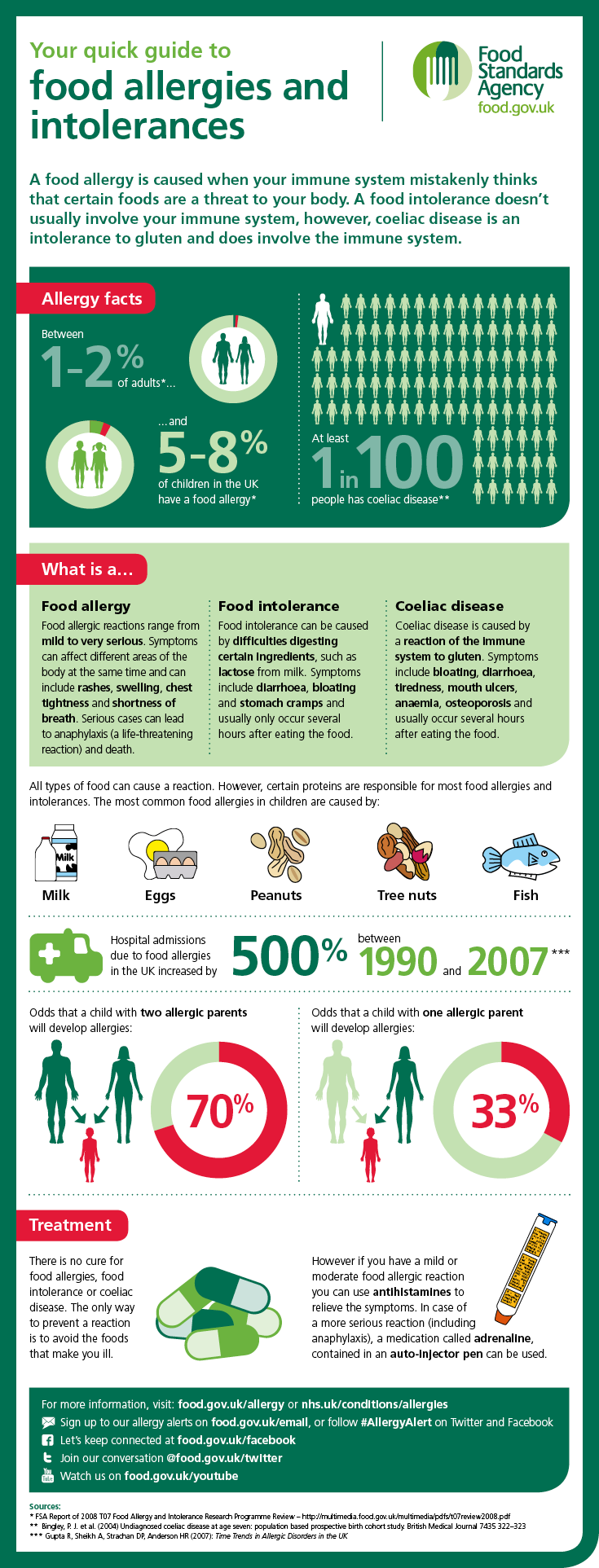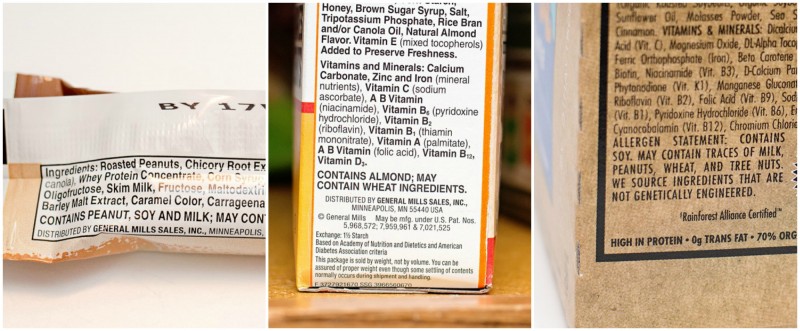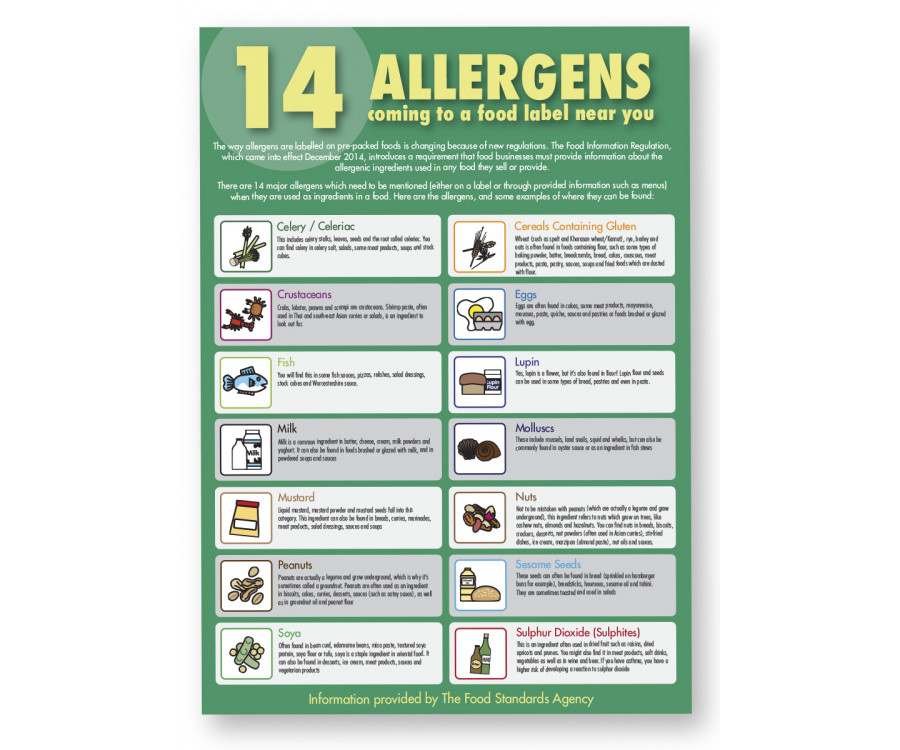43 allergens required on food labels
Precautionary allergen labelling checklist | Food Standards Agency The 14 mandatory allergens: celery cereals containing gluten (such as barley and oats) crustaceans (such as prawns, crabs, and lobsters) eggs fish lupin milk molluscs mustard peanuts sesame... Allergen Labeling Requirements — FDA Reader Highly refined oils derived from one of the eight major allergens do not need to comply with FALCPA allergen labeling requirements (e.g. soybean oil, peanut oil) If you believe that an allergen containing ingredient should not require an allergen warning (because it will not elicit an allergic response) then you may submit a petition to exempt that ingredient from allergen labeling.
Food Labels: Read It Before You Eat It! - AAAAI Ingredients of these most common eight allergens must be labeled with clearly recognized English names of the food source as listed above. The "contains" statement is "voluntary", but if used, must include ALL of the allergenic ingredients from the list of eight allergenic sources as described in item 14 of the 2006 guidance document.

Allergens required on food labels
How to Read a Food Label | Food Allergy Research & Education While all ingredients in a food are supposed to be listed in the ingredients list, FALCPA covers only the eight most common allergens. These are milk, egg, peanut, tree nuts, soy, wheat, fish and crustacean shellfish. Note that molluscan shellfish—such as oysters, clams, mussels or scallops—are not required to be labeled as a major allergen. › common-allergens › tree-nutTree Nut | Food Allergy Research & Education Tree nuts are one of the eight major allergens that must be listed in plain language on packaged foods sold in the U.S., as required by federal law, either within the ingredient list or in a separate “Contains” statement on the package. For tree nuts, the specific variety must also be identified on the package. Food Allergen Labelling - Canada.ca Based on consultations with stakeholders, including allergy associations and the medical community, Health Canada developed amendments to the Regulations to enhance labelling requirements for specific priority allergens, gluten sources and added sulphites in prepackaged foods sold in Canada.
Allergens required on food labels. Allergen labelling (Safety - About enzymes) - AMFEP Regulation (EC) 1169/2011 on Food Information to Consumers requires all allergens to be labelled. This regulation lists the ingredients or substances with known allergenic potential. This list has been built based on the opinions of the EFSA Scientific Panel on Dietetic Products, Nutrition and Allergies relating to the evaluation of allergenic foods for labelling purposes (EFSA, 2004, EFSA ... 8 Required Information On Food Packaging Labels Food Product Label Checklist. In order to ensure compliance with FDA and USDA regulations, your product packaging should contain the following information: 1. Expiration Date. Nearly every packed food product has an expiration date that informs the buyer whether the product is consumable or not. Allergen Labeling on Food Products | Mississippi State University ... The Food Allergen Labeling and Consumer Protection Act (FALCPA), which took effect on January 1, 2006, requires food manufacturers to use common names to identify major allergens. Allergen declaration is required on products regulated by the Food and Drug Administration (FDA), U.S. Department of Agriculture (USDA), and state regulatory authorities (e.g., Mississippi Department Food Allergy & Anaphylaxis | Food Labeling | Food Labels Only crustacean shellfish (e.g. crabs, shrimp, lobster, or crayfish) and not mollusks (eg. clams, mussels, scallops, or squid) are required to be labeled on packaged goods. The labeling law applies only to foods regulated by the FDA.
Food Labelling | Allergy UK | National Charity The allergen content of foods packaged within the European Union are required by law to include allergen information (Regulation No 1169/2011). This legislation has been in place since December, 2014 and mandates that ingredient lists on food labels have to clearly highlight (for example in bold type) that they contain any of the 14 allergens which include: Allergen labelling for food manufacturers 14 allergens If your product contains any of the main 14 allergens as an ingredient or processing aid, it must be included on the label. The 14 main allergens are: celery cereals containing gluten... Have Food Allergies? Read the Label | FDA milk egg fish, such as bass, flounder, or cod crustacean shellfish, such as crab, lobster, or shrimp tree nuts, such as almonds, pecans, or walnuts wheat peanuts soybeans The law requires that food... Allergens | Food Information | Food Legislation | Legislation | The ... 14 Allergens There are 14 allergens that must be declared by law Cereals containing gluten - wheat (such as spelt and khorasan wheat), rye, barley, oats Note: The cereal name e.g 'wheat', must be declared and highlighted, not 'gluten' Crustaceans e.g. crabs, prawns, lobsters Eggs Fish Peanuts Soybeans Milk
Food Labelling & Allergen Guide - Australian Food and Grocery Council All food manufacturers in Australia are required by law to provide nutrition information panels on food products, including information on energy (kilojoule), protein, fat, carbohydrate, sugar and sodium content. In addition, product labels need to carry a list of ingredients, a declaration of any major allergens and the percentage content of ... › food-labelling-and-packagingFood labelling and packaging: Ingredients list - GOV.UK The allergens you need to highlight and list are: celery cereals containing gluten - including wheat, rye, barley and oats crustaceans - including prawns, crab and lobster eggs fish lupin milk... Understanding Labels - Living Confidently with Food Allergy - A Guide ... Read the label before serving a food even if it has been "safe" in the past. Remember that ingredients can change without notice. Read ingredient lists carefully from start to finish. Food companies do not have to make allergens stand out in any way (e.g. bolding, italicizing, or underlining the print). Do not buy a packaged food product that does not have an ingredient label. Food labelling and allergens - AFSA "Common allergen" is defined as: egg, cow's milk, crustaceans and molluscs, fish, peanuts, soybeans, tree nuts and any significant cereals, as well as ingredients derived from these foodstuffs that has retained its allergenicity in the final product. Goats milk shall, according to R.146, be labelled in the same manner as common allergens.
Food labelling - general EU rules - Your Europe Complete list of allergens - annex 2 Allergens - EU guidance Labelling Mandatory information must be printed using a font with a minimum x-height of 1.2 millimetres. If the largest surface area of packaging is less than 80 cm², you can use a minimum x-height of 0.9 mm. For packaging surface of less than 10 cm², you must list: name of the food
Food allergy labelling Standard 1.2.3 requires the most common food allergens to be declared on food labels. Where labels are not required (for example, food served in restaurants etc) this information must be provided to the consumer on request, either verbally or in writing. The allergens that must be declared when they are an ingredient; or an ingredient of a ...
Allergen labelling - Food Standards You can read more about product exemptions from allergen labelling. Aged bottled wine. Before 2002 wine producers were not required to declare allergens on their product label. However, food allergens such as egg, fish, milk, and tree nuts as well as sulphites may have been used in the production of these wines.
inspection.canada.ca › food-labels › labellingList of ingredients and allergens on food labels - Food ... When present in a prepackaged product, the following ingredients and their components are not required to be declared in the list of ingredients, unless they contain known allergens, gluten, or added sulphites at quantities greater than or equal to 10 parts per million. Refer to Food allergen, gluten and added sulphite declaration for exceptions.
Food Allergies and Labelling - What You Need to Know The 10 common allergens are: 1 - Milk and milk products 2 - Fish and fish products (including shellfish) 3 - Crustacea (e.g. crab, crayfish, prawns) 4 - Peanuts and their products 5 - Tree nuts 6 - Sesame seeds 7 - Lupin 8 - Soy, soybeans and their products 9 - Eggs and egg products
Food Allergen Labelling | Laws. Types Of Labels, Effectiveness There are 14 food allergens that you need to be aware of and these ingredients must be clearly marked and declared on any food offered for sale. Nuts (almonds, hazelnuts, walnuts, pecan nuts, sesame, Brazil nuts, pistachio, cashew, Macadamia or Queensland nut). Peanuts. Eggs including egg derived substances such as albumen. Milk and dairy.
› food › food-allergensgluten-freeFood Allergen Labeling and Consumer Protection Act of 2004 Mar 07, 2022 · (b) Effect on Other Authority.--The amendments made by this section that require a label or labeling for major food allergens do not alter the authority of the Secretary of Health and Human ...
Allergen labelling for our foods | Eufic The allergens include cereals containing gluten, fish, crustaceans, eggs, peanuts, soy, milk and dairy products including lactose, nuts, celery, mustard, sesame seed, and sulphites. They are responsible for over 90% of all allergic reactions.
FDA: Food Labels Must List Allergens - WebMD Manufacturers are required to identify in plain English the presence of ingredients that contain protein derived from the following: Milk Eggs Fish Crustacean shellfish (like shrimp) Tree nuts...
foodinstitute.com › focus › big-8-allergensThe Big 8 Food Allergens May 09, 2020 · [Editor’s Note 1/13/2022: Please see our updated list that includes sesame here: The Big 9 Food Allergens] More than 170 foods have been reported to cause allergic reactions, but eight major food allergens, also known as the Big 8, are responsible for most of the serious food allergy reactions in the U.S., according to Food Allergy Research & Education.

Press Room - 2017 - January 10 - Food Allergy Research & Education | Food allergies, Food labels ...
› food › food-labeling-nutritionFood Allergies | FDA Apr 18, 2022 · Food Labels and Allergens. ... The FDA can carry out a number of regulatory actions if a food label lacks required allergen information for a food ingredient, if a food product is found to ...
Label: Allergens - Food label These are: Celery, cereals containing gluten, crustaceans (e.g. prawns or crab), eggs, fish, lupin, milk, molluscs (e.g. clams or mussels), mustard, nuts, peanuts, sesame, soybeans and sulphur dioxide.
Food Allergen Labeling Law Requirements and Exceptions Tree nuts (e.g., pecans and almonds) Peanuts Wheat, and Soybeans According to the FDA, these are the allergens that cause the most problems in the U.S. Foods that contain these allergens need to list them in the ingredients label on the package. In addition, manufacturers must use use the "common or usual name" of the allergen.
inspection.canada.ca › food-labels › labellingManner of declaring - List of ingredients and allergens on ... Food allergens, gluten and added sulphites. Food allergens and gluten must be declared in the list of ingredients in which they are present, or in a "food allergen source, gluten source and added sulphites statement" (definition), by their prescribed source names [B.01.010.1(2), FDR].
Food Allergen Labelling - Canada.ca Based on consultations with stakeholders, including allergy associations and the medical community, Health Canada developed amendments to the Regulations to enhance labelling requirements for specific priority allergens, gluten sources and added sulphites in prepackaged foods sold in Canada.
› common-allergens › tree-nutTree Nut | Food Allergy Research & Education Tree nuts are one of the eight major allergens that must be listed in plain language on packaged foods sold in the U.S., as required by federal law, either within the ingredient list or in a separate “Contains” statement on the package. For tree nuts, the specific variety must also be identified on the package.
How to Read a Food Label | Food Allergy Research & Education While all ingredients in a food are supposed to be listed in the ingredients list, FALCPA covers only the eight most common allergens. These are milk, egg, peanut, tree nuts, soy, wheat, fish and crustacean shellfish. Note that molluscan shellfish—such as oysters, clams, mussels or scallops—are not required to be labeled as a major allergen.












Post a Comment for "43 allergens required on food labels"